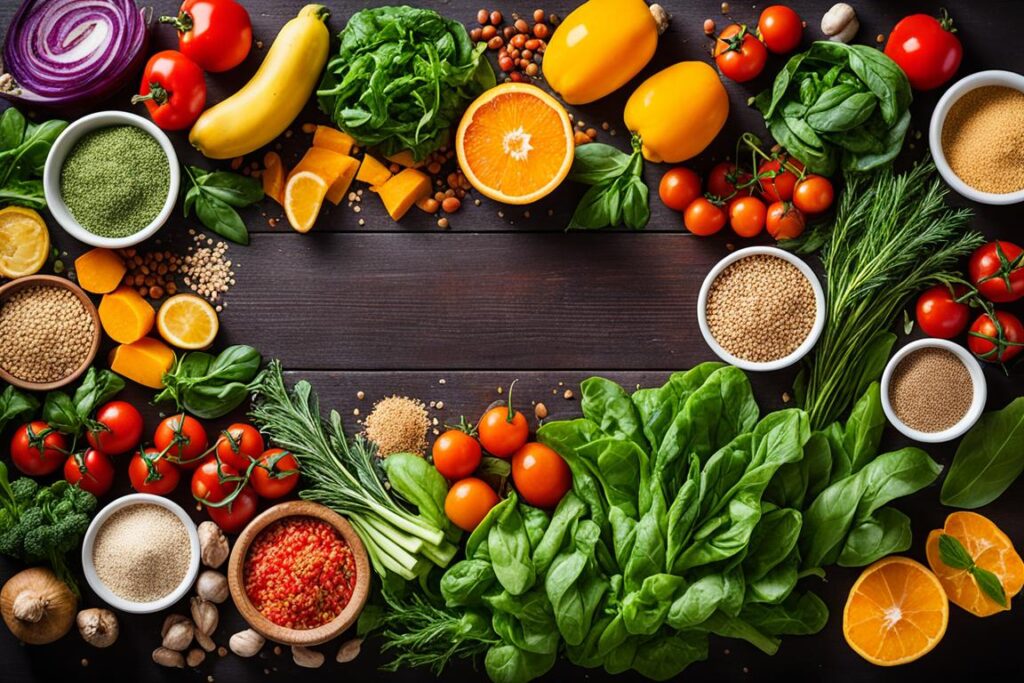Welcome to the fascinating world of wine, beer, and spirits! Whether you’re a seasoned connoisseur or just getting started on your journey, this comprehensive guide will take you on an exciting exploration of alcoholic beverages. From wine tasting and craft beers to spirits reviews and cocktail recipes, we have all the information you need to enhance your knowledge and enjoyment of these delightful libations.
Discover the rich flavors and aromas of different wines as you learn the art of tasting and appreciation. Uncover the secrets behind craft beers and explore the diverse range of spirits available. Try your hand at creating delicious cocktails with our expertly curated recipes. And when you’re ready to find the perfect bottle for any occasion, we’ll guide you to the best liquor stores both near and far.
So, grab a glass and join us as we embark on an adventure into the world of wine, beer, and spirits. Cheers!
Key Takeaways:
- Embark on a journey of discovery in the world of wine, beer, and spirits.
- Learn the art of tasting and appreciation to enhance your drinking experience.
- Explore the wide variety of craft beers and spirits available.
- Create impressive cocktails with our handpicked recipes.
- Find the best liquor stores to satisfy your beverage desires.
The Art of Tasting and Appreciation.
In this section, we will delve into the art of tasting and appreciating different types of wine, craft beers, and spirits. Whether you’re a seasoned connoisseur or just starting your journey, understanding how to evaluate flavors, aromas, and the intricacies of each beverage is key to developing a deeper appreciation for the diverse world of alcoholic beverages.
Tasting Wine
When it comes to wine tasting, it’s important to engage all your senses. Start by observing the color and clarity of the wine in your glass. Take a moment to appreciate its hue and note any reflections. Next, swirl the wine gently to release its aromas. Bring the glass to your nose and inhale deeply, identifying the various scents that emerge. Now, take a small sip and let the wine coat your palate. Pay attention to the different flavors and textures on your tongue. Is it fruity, earthy, or oaky? Does it have a smooth or crisp finish? Take your time to savor each sip and notice how the wine evolves as it lingers in your mouth.
Discovering Craft Beers
Craft beers offer a myriad of flavors and styles, making them a true delight for beer enthusiasts. To appreciate craft beers to their fullest, start by pouring the beer into a glass designed for its specific style. This will allow the aromas and flavors to fully develop. Take a moment to observe the beer’s color, clarity, and carbonation. Bring the glass to your nose and inhale the aromas, identifying the different hoppy, malty, or fruity notes. Take a sip and let the beer coat your palate, noting its body, bitterness, and complexity. Craft beers often have unique flavor profiles, so take the time to explore and discover your preferences.
Exploring Spirits
Spirits like whiskey, rum, and vodka have distinct characteristics that can be appreciated through a guided tasting experience. When tasting spirits, start by noting their appearance. Is it clear or aged? Swirl the spirit gently in your glass to release its aromas. Bring the glass to your nose and inhale the scents, identifying the different notes of spices, fruits, or wood. Take a small sip and let the spirit linger on your palate. Pay attention to the flavors, mouthfeel, and finish. Is it smooth, smoky, or sweet? With each sip, you’ll uncover new depths and complexities.
Wine Pairings
Enhance your wine tasting experience by exploring the art of wine pairings. Matching food with the right wine can elevate both the flavors of the dish and the wine itself. When selecting wine pairings, consider the characteristics of the wine, such as its acidity, body, and tannins. Light-bodied wines with bright acidity pair well with seafood and lighter dishes, while full-bodied wines with robust flavors complement rich meats and cheeses. Additionally, consider the flavors and textures of the dish, aiming to create a harmonious balance with the wine.
Quick Guide to Wine Pairings
| Wine Type | Food Pairing |
|---|---|
| Chardonnay | Grilled chicken, creamy pasta dishes |
| Pinot Noir | Salmon, roasted vegetables |
| Cabernet Sauvignon | Steak, aged cheeses |
| Sauvignon Blanc | Goat cheese, seafood salads |
By exploring the art of tasting and appreciation, and discovering the perfect wine pairings, you’ll unlock a deeper understanding and enjoyment of wine, craft beers, and spirits. So go ahead, embark on this sensory adventure and savor the intricate world of alcoholic beverages.
The Production and Variety of Wine, Beer, and Spirits.
Understanding the production processes behind your favorite beverages can deepen your knowledge and appreciation for wine, beer, and spirits. In this section, we will explore the techniques used in grape cultivation, brewing, and distillation. We will also highlight top distilleries, beer brewing methods, and provide insights into home brewing.
The Craftsmanship of Wine
Wine production begins with carefully cultivated grapes. Vineyards around the world nurture different grape varieties, each contributing unique flavors and characteristics to the final product. Through meticulous grape selection, harvesting, and pressing, winemakers extract the juice, which undergoes fermentation to transform into wine. The aging process further enhances the quality, complexity, and flavor profiles of wines.
The Art of Beer Brewing
Beer brewing has a rich history dating back centuries. From traditional breweries to innovative craft beer producers, a wide variety of brewing methods and styles exist. The process typically involves malted barley, water, hops, and yeast. Each ingredient plays a crucial role in determining the color, aroma, bitterness, and alcohol content of the final beer. Whether it’s a refreshing lager, hop-forward IPA, or rich stout, the art of beer brewing continually evolves, giving beer lovers an endless array of options to explore.
Home Brewing: Unleashing Creativity and Passion
For beer enthusiasts looking to take their love for the craft to the next level, home brewing offers a fantastic opportunity to experiment and create unique brews. Home brewers have the freedom to customize ingredients, flavors, and brewing techniques according to their preferences. It’s a chance to unleash creativity and passion for the art of brewing within the comfort of their own homes. With the right equipment and knowledge, home brewers can produce high-quality beers that rival those found in commercial breweries.
Exploring Distilleries and Distillation
When it comes to spirits, distillation is the key process that separates alcohol from fermented substances. Distilleries, whether large-scale or artisanal, produce a wide range of spirits such as whiskey, rum, vodka, and gin. Each spirit undergoes a unique distillation process, involving heating, cooling, and condensation, to achieve the desired characteristics. From single malt whiskies aged in oak barrels to small-batch craft gins infused with botanicals, distilleries showcase the artistry and expertise of master distillers.
By delving into the production processes of wine, beer, and spirits, you gain insight into the craftsmanship and history behind these beverages. Whether you’re savoring a glass of fine wine, enjoying a beer with friends, or sipping a handcrafted cocktail, knowing the journey from the vineyard, brewery, or distillery to your glass adds another layer of appreciation to your drinking experience.
| Top Distilleries | Location |
|---|---|
| Macallan Distillery | Speyside, Scotland |
| WhistlePig Farm | Vermont, USA |
| Hacienda Patrón | Jalisco, Mexico |
| Four Roses Distillery | Kentucky, USA |
| Talisker Distillery | Isle of Skye, Scotland |
Exploring Wine Regions and Alcoholic Trends.
Embark on a fascinating journey as we explore the diverse wine regions around the world. From the picturesque vineyards of France to the sun-soaked valleys of California, each region boasts unique characteristics that contribute to the creation of exceptional wines.
Terroir plays a crucial role in shaping the flavors and aromas of wine. It encompasses the natural elements, such as soil composition, climate, and vineyard elevation, that contribute to the distinctive characteristics of wines from a specific region. The influence of terroir gives wines from different regions their own distinct profiles, making each sip a truly sensorial experience.
Whether you fancy bold and robust reds, crisp and refreshing whites, or sparkling varieties that tickle your palate, exploring wine regions allows you to discover new flavors and expand your taste horizons.
Current Alcohol Trends
In addition to exploring wine regions, it’s essential to stay informed about the latest alcohol trends. The world of wine is constantly evolving, with emerging styles, varietals, and innovative winemaking techniques.
One prominent trend is the growing popularity of organic, biodynamic, and sustainable winemaking practices. Consumers are increasingly seeking wines that are produced with minimal intervention and respect for the environment, resulting in more conscious and eco-friendly choices.
Moreover, natural wines, made with minimal additives and using traditional winemaking techniques, are gaining attention among wine enthusiasts. These wines showcase the pure expression of the grapes and reflect the unique characteristics of the terroir.
Wine pairings are another trend that enhances the dining experience. Gone are the days of arbitrary food and wine combinations. Nowadays, there is a focus on carefully matching wines with specific dishes to create harmonious flavor profiles. From classic pairings like Cabernet Sauvignon with steak to adventurous combinations like Sauvignon Blanc with sushi, there are endless possibilities to elevate your dining experience.
Wine Regions and Pairings
| Wine Region | Signature Wines | Recommended Pairings |
|---|---|---|
| Napa Valley, California | Cabernet Sauvignon | Grilled steak, herb-roasted lamb |
| Bordeaux, France | Merlot, Cabernet Sauvignon | Beef bourguignon, roasted duck |
| Tuscany, Italy | Chianti, Sangiovese | Pasta with tomato sauce, margherita pizza |
| Barossa Valley, Australia | Shiraz | Barbecue ribs, grilled kangaroo |
These are just a few examples of the countless wine regions and their exquisite signature wines. Exploring wine regions and their recommended pairings allows you to enhance your enjoyment of both the wine and the food, creating a truly memorable dining experience.
Continuing on our journey to becoming connoisseurs of wine, beer, and spirits, let’s now turn our attention to the responsible consumption of these delightful beverages. Section 5 will highlight the importance of responsible drinking and the potential disadvantages associated with excessive alcohol consumption.
Responsible Drinking and Potential Disadvantages.
When it comes to enjoying alcoholic beverages, responsible drinking is crucial. Understanding the potential disadvantages associated with excessive alcohol consumption is essential for maintaining a healthy and balanced lifestyle. Let’s explore the health risks, addiction concerns, and financial costs related to irresponsible drinking.
Health Risks of Excessive Alcohol Consumption
Excessive drinking can have detrimental effects on your health. Health risks associated with long-term alcohol abuse include liver disease, heart problems, and mental health issues. Alcohol can damage the liver, leading to liver inflammation, cirrhosis, and even liver failure over time. Additionally, excessive alcohol consumption can contribute to heart disease, high blood pressure, and an increased risk of stroke. Mental health issues such as depression, anxiety, and cognitive impairment can also be exacerbated by heavy drinking.
Risks of Addiction and Dependence
Addiction and dependency are common risks associated with excessive alcohol consumption. Addiction occurs when an individual becomes physically and psychologically dependent on alcohol. This dependency can lead to an inability to control cravings, withdrawal symptoms when attempting to quit, and a persistent need to drink despite negative consequences. Recognizing the signs of addiction and seeking appropriate support is essential for combatting this issue.
Financial Costs of Irresponsible Drinking
Irresponsible drinking can also result in significant financial costs. Regularly purchasing alcoholic beverages can place a strain on your budget and financial well-being. Whether it’s purchasing drinks at bars, restaurants, or liquor stores, the cumulative costs can quickly add up. By practicing responsible drinking habits, you can avoid unnecessary expenses and allocate your resources towards more important aspects of your life.
“Drink because you are happy, but never because you are miserable.” – G.K. Chesterton
Adopting responsible drinking habits is not only beneficial for your health and well-being but also for fostering a healthier relationship with alcohol. Moderation is key to ensuring that you can enjoy the pleasures of alcoholic beverages while still maintaining control and minimizing the potential disadvantages.
| Disadvantages | Effects |
|---|---|
| Health Risks | Liver disease, heart problems, mental health issues |
| Addiction and Dependence | Inability to control cravings, withdrawal symptoms, persistent need to drink |
| Financial Costs | Strain on budget, unnecessary expenses |
Understanding the potential drawbacks of excessive alcohol consumption empowers you to make informed decisions. By practicing responsible drinking, you can prioritize your health, well-being, and financial stability.
By being mindful of your alcohol consumption and embracing moderation, you can strike a balance that allows you to savor the flavors and aromas of your favorite beverages while safeguarding your overall health and happiness.
Conclusion.
In conclusion, the world of wine, beer, and spirits offers a fascinating journey for enthusiasts and connoisseurs alike. By exploring the art of tasting and appreciation, you can develop a deeper understanding and enjoyment of these diverse beverages.
Understanding the production processes behind these libations is also crucial. Whether it’s the craftsmanship of top distilleries or the intricate techniques used in beer brewing, knowledge of these methods adds another layer of appreciation to your favorite drinks.
Moreover, staying informed about current trends and wine pairings allows you to explore new flavors and experiences. From the renowned wine regions around the world to the latest alcohol trends, there is always something exciting to discover.
However, it’s important to remember the value of responsible drinking. While the world of wine, beer, and spirits offers enjoyment and pleasure, excessive consumption can lead to health risks and addiction. By practicing moderation and staying aware of potential drawbacks, you can fully embrace the wonderful world of alcoholic beverages.



